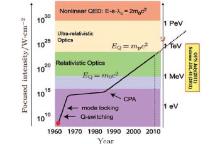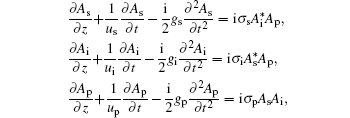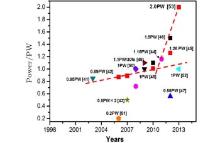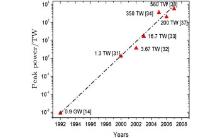Corresponding author. E-mail: liangxy@siom.ac.cn
Corresponding author. E-mail: ruxinli@mail.shcnc.ac.cn
Project supported by the National Natural Science Foundation of China (Grant Nos. 61378030 and 11127901), the National Basic Research Program of China(Grant No. 2011CB808101), and the International S&T Cooperation Program of China (Grant No. 2011DFA11300).
Since the proof-of-principle demonstration of optical parametric amplification to efficiently amplify chirped laser pulses in 1992, optical parametric chirped pulse amplification (OPCPA) became the most promising method for the amplification of broadband optical pulses. In the meantime, we are witnessing an exciting progress in the development of powerful and ultrashort pulse laser systems that employ chirped pulse parametric amplifiers. The output power and pulse duration of these systems have ranged from a few gigawatts to hundreds of terawatts with a potential of tens of petawatts power level. Meanwhile, the output pulse duration based on optical parametric amplification has entered the range of few-optical-cycle field. In this paper, we overview the basic principles, trends in development, and current state of the ultrashort and laser systems based on OPCPA, respectively.
The laser is arguably one of the most important inventions of the last century. Ever since the first demonstration of the ruby laser in 1960, [1] a large community of researchers has continually designed and improved new types of laser systems to increase the peak power of laser pulse (as shown Fig.1<sup>[2]). However, before 1985, the laser amplifiers were restricted to directly amplifying even short input pulses. The risk of optical damage of the gain media, due to the self-focusing caused by the change of intensity-dependent refractive index, was confronting the amplification above few-terawatt power levels with the manageable beam sizes.[2] The chirped pulse amplification (CPA) was first introduced in 1985 by Strickland and Mourou[3] to overcome the problem of nonlinear effects and optical damage with increasing energies of short pulses, which is schematically depicted in Fig.2. In this scheme, the initial laser pulse is stretched by imposing a large amount of group-velocity dispersion on it in a dispersive delay line. The peak intensity of this " chirped" pulse will then be lowered by a factor proportional to the amount of pulse stretching. The chirped pulse is amplified in the conventional way, and sent into another dispersive delay line which introduces exactly the opposite amount of group-velocity dispersion to the pulse. As a result, the pulse will be recompressed to its original duration (provided that the spectrum has not been altered by the amplifier), with the accompanying increase in peak intensity. The pulse stretching and compression can be obtained by a number of different setups such as, grating pairs (shown in Fig.3), [4, 5] prism pairs, [6] grism pairs (a combination of a grating and prism), [7] high-dispersive mirrors, [8] and material.[8– 10] Since pulse compressors can in practice be constructed using only reflective optics, the damage threshold of such a compressor is much higher than that of a typical laser amplifier system. Therefore, chirped pulse amplification has led to a dramatic increase in the maximum achievable peak intensity.
 | Fig.1. Progress in laser focused intensity.[2] |
Besides the laser amplification based on laser gain materials, the optical parametric amplifiers (OPA) closely followed the trends in development of lasers. Unlike the laser amplifiers, OPAs do not involve any real energy levels. Three-wave interactions mediated by the second-order nonlinearity in birefringent materials offer unique possibilities for light amplification. In this nonlinearity medium, which was seeded by a suitable frequency laser beam, parametric generation originates from the pump photon splitting into a pair (signal and idler) of photons at any ratio that conserves energy and momentum. Phase matching conditions define the splitting ratio, thus giving complete tuning range (or amplification bandwidth) to be accessed. The gain bandwidth of a conventional collinear OPA in the simplest case (monochromatic pump, plane-wave approximation, and low pump depletion) can be derived by solving a set of truncated three-wave interaction equations[11]

where AsAi, and Ap are complex amplitudes of signal, idler, and pump waves, respectively. u, g, and σ are the group velocity, group-velocity dispersion (GVD), and nonlinear coupling coefficients of signal, idler, and pump waves denoted by the subscript. In this approximation, the gain bandwidth of the OPA in wavenumbers is given by[12]


where 1/usi = 1/us – 1/ui is the group-velocity mismatch between the signal and idler pulses, gs, i = ∂ 2ks, i/∂ ω 2ω = ω p and L is the medium (interaction) length, and Γ is the parametric gain factor

where Ip is the pump intensity, deff is the effective nonlinear coefficient, ω s and ω i are the frequencies of the signal and idler waves, respectively, and n denotes the refractive index of the waves labeled by the subscript. It has to be noted that, in the more general case, with pump pulse depletion accounted for, the amplification bandwidth must be estimated numerically. In addition, the amplification bandwidth can be notably extended by use of noncollinear geometry, [13] promising more than full octave gain bandwidth to be achieved.
Based on the above characteristics of OPA, the proof-of-principle demonstration of OPA to amplify broadband chirped pulses has been first carried out by Dubietis et al. in 1992, [14] which has been aptly named optical parametric chirped pulse amplification (OPCPA). In OPCPA scheme, a chirped low intensity pulse is used to seed an OPA which is pumped by a high energy pulse (usually from a separate laser system). Due to the parametric amplification occurs instantaneously, the seed pulse should be chirped such that it matches the pump pulse duration, and both the two pulses should be accurately synchronized.[15] After amplification, the pulse is recompressed to yield a high intensity ultrashort pulse. In 1997, this idea was further elaborated by Ross and coauthors by offering several practical designs of OPCPA based laser systems for potentially delivering ultrashort laser pulses with petawatt peak power.[16] Since that time OPCPA (collinear and noncollinear) became a widely recognized and rapidly developing amplification technology.[17] At the same time, the development of advanced nonlinear techniques and growth of novel efficient nonlinear crystals (borate series for visible and near infrared, new types of semiconductor crystals for mid-infrared, and finally periodically poled materials) boosted OPAs on the top of extensive research. Nowadays, the typical nonlinear crystals used in OPCPA are KDP, DKDP, LBO, BBO, and YCOB, whose parameters are listed in Table1.[18] Commonly, gain media for these OPCPA preamplifiers are BBO, LBO, and YCOB because of their high nonlinearity. Conversely, for the power amplifiers, KDP and DKDP crystals are used for their large apertures. However, its recent development of LBO crystal, which is illustrated in detail in Ref. [19], for larger size growth makes it possible for high-energy amplification.
| Table 1. Nonlinear optical crystal parameters (λ pump = 532nm, λ signal = 1053nm, Ip = 0.5GW· cm– 2, τ = 3ns). |
With increasing demand of ultrashort pulse amplification that requires extremely broad gain bandwidth, several methods based on OPA operation have been developed. Firstly, it has been widely recognized that OPA may exhibit an extremely broad amplification bandwidth at the degeneracy. Generally, the method to expand its amplification bandwidth further was proposed for multi-pass OPA, where either each pass was independently tuned to amplify a different spectral portion of the continuum seed source[20] or by the use of several slightly phase-mismatched pump beams in a single pass.[21] Since the development of advanced nonlinear techniques and increasing demand of ultrashort light pulses at new wavelengths, not supported by lasing media, application of noncollinear geometry enables one to create a degeneracy-like situation over all the tuning range. Unlike the laser oscillators, where the bandwidth is limited by the characteristic of laser medium, the OPA may produce picosecond and femtosecond pulses broadly tunable from 0.2 up to 20 μ m in different noncollinear matching conditions.[12, 22, 23]
Moreover, in the generation of high intensity laser pulses, OPCPA has some very interesting properties compared with conventional amplifiers such Ti:sapphire-based systems, which are operated on the well-known laser principles of energy storage in a population-inverted medium. The most important advantages are: (i) The huge single-pass gain. Typically, the small-single gain in an OPA can be orders of magnitude larger than what can be reached with conventional amplifiers, so that only a few amplification passes are needed to obtain a high pulse intensity. (ii) The spectral gain bandwidth of an OPA (especially in noncollinear geometry) can be significantly broader than any other known type of laser amplifier, allowing the amplification of shorter pulses. (iii) As parametric amplification is an instantaneous process, no energy is ever stored in the amplifier medium. This medium only plays the role of a passive host, providing the required nonlinear coupling between the waves. Therefore, the thermal effects that usually limit the performance of e.g. high-energy Ti:sapphire amplifiers are virtually absent in OPCPA. (iv) While laser amplifiers usually suffer from amplified spontaneous emission (ASE) even parasitic lasing (PL) in largeaperture laser crystal, in an OPA, this is less of a problem; although OPA does emit spontaneous parametric fluorescence, this is only present during the pump pulse and its energy is usually much less than typical laser ASE.
Based on OPCPA, many ultrashort laser pulses and high peak power laser systems have been demonstrated in practice during the last several decades. Even now, it is also a quite attractive technology for implementation of ultrashort or ultrahigh peak-power laser pulses, which will be further expressed in Sections3 and 4, respectively.
The typical setup to generate few-cycle optical pulses based on OPA is combination of noncollinear optical parametric amplification (NOPA) of seeded femtosecond white light continuum and compressor, which was first demonstrated in Ref. [24]. Later on, several groups contributed to its further development in the direction of pulse shortening. The development towards ultimate short pulses is depicted in Fig.4, the main issue addressed in the development was adjusting the negative group-velocity dispersion of the compressor to compensate for the continuum chirp as well as for the positive group-velocity dispersion of the optical components used.[25] Minimization of the amount of dispersive material along with application of small apex angleprism compressor and chirped mirrors has led to generation of sub-8fs pulses.[27] Precompression of the seed pulse prior to amplification and compression, using prism/grating orprism/chirped mirror combinations, enabled production of sub 5fs pulses.[28, 29] The pulse-front-matched pump geometry has been realized in a NOPA system providing sub 10fs pulses tunable in the visible and the near infrared, [28] with even shorter pulses of 6.1-fs duration tunable in the visible spectra lrange (from 550 to 700nm). The same group reported on the similar system one year later, demonstrating pulses as short as 4.7fs.[29] In 2002, performing several improvements over the latest works, the parametric amplification of a continuous simultaneously phase-matched 250-THz spectrum was demonstrated.[30] The resultant signal pulses with spectrum extending through visible to near-infrared were compressed down to 3.9-fs duration, which is still the shortest pulse duration based on NOPA at present, obtained in amodern NOPA configuration. These improvements included seed precompression, pump pulse stretching, and utilization of gain bandwidth broadening due to introduced angular dispersion of the pump beam. Feedback with iterative optimization based on second-harmonic generation frequency resolved optical gating was applied to match the spectral phase of parametrically amplified chirped pulse for achieving optimal compression. The improved compressor consisted of a pair of chirped mirrors and a grating dispersion line with a micromachined flexible mirror.
Summarizing the latest achievements, few-optical-cycle pulses were generated and amplified by the NOPA, which exhibits several advantages, namely, a much broader gain bandwidth, a lower stretching and compression factor, a scalability to high power, and the compactness.
Typical OPCPA setup involves one or several preamplifiers and a power amplifier that utilize nonlinear crystals. The frequency doubled nanosecond or sub-nanosecond neodymium-doped material-based lasers serve as a pump source properly synchronized with the femtosecond seed laser (Ti:sapphire oscillator in the most common case).
Based on the classical OPCPA scheme, the progress toward high output peak powers is illustrated in Fig.5. The plotted dots represent the highest experimental achievements in the field. The pioneering work that demonstrated 70-fs pulses with peak power of 0.9GW[14] stands as a starting point in the plotted trend. The non-collinear OPA geometry was used in BBO crystal to amplify a broadband signal laser centered at 1053nm. The very first high power OPCPA system was launched in 2000, delivering 300 fs pulses with peak power of 1.3TW, [31] which involved a KDP OPA final amplifier worked at the degeneracy and still centered at 1053nm. In 2002, 155-fs pulses with nearly tripled peak power were attained.[32] One year later, 120-fs pulses with peak power of 16.7TW had been reported.[33] The final amplifier operated at the degeneracy based on LBO crystal was used in both of these laser systems. In general, due to the narrow gain bandwidth at the degeneracy, it is difficult to compress the final pulse duration below 100fs. In addition, although the sub-petawatt power level with 85fs, 35J[34] has been achieved in 2006, a problem of the parasitic second-harmonic generation has been inevitable, it remains the main factor that limits conversion efficiency and pulse contrast ratio of OPCPA. The general way to guarantee the high contrast required for ultrahigh intensities is short pulse duration pump OPCPA. For example, the petawatt field synthesizer (PFS), [35] being developed at the Max Planck Institute fü r Quantenoptik (MPQ) in Germany (as shown in Table2), will have the shortest pulse duration of 5fs and aim to deliver 3J to have 0.6PW, fully based on short-pulse-pump OPCPA. However, one of the greatest challenges of the system is the development of the pump source which will have a duration of 1– 2 ps and will be entirely diode pumped, with an end goal of having a repetition rate of 10Hz.[36]
| Table 2. Summary of OPCPA based petawatt systems. |
Then, the researchers started to apply the non-collinear geometry to the large-aperture nonlinear crystal (DKDP) for higher output power centered at 910nm. Commonly, the KDP crystal, which shows a broadband gain near 1 μ m, does not show a big gain bandwidth at 910nm, but the region of gain spectrum will shift to shorter wavelength with the deuteration ratio increasing (DKDP). The numerical simulation of OPCPA based on DKDP shows that any deuteration above 70% is appropriate and would satisfy the broadband amplification requirements centered at 910nm. The sub-petawatt levelwith 45fs, 14.5J[37] and 43fs, 38J[38] laser pulses, corresponding to peakpower of 200 and 560TW, respectively, were naturally generated. Moreover, the vulcan 10PW project[39] of the Rutherford Appleton Laboratory (RAL) in the United Kingdom has been put forward recently (as shown in Table2). The choice of using non-collinear OPCPA here is also in line with the contrast and control of parasitic fluorescence. Pre-amplification to the Joule level will be performed in LBO while power amplification to 300 J will be with DKDP. The vulcan laser, an existing glass-based laser amplifier chain that can deliver 2× 1.5kJ beams at 1053nm in 3ns, will be frequency doubled and will act as the pump for the power amplification stage.[40]
In summary, the progress in solid-state laser amplifiers and the wide frequency tenability of OPCPA offered the possibility of implementing near petawatt pulse laser. However, further increase in amplified energy was limited in the size of nonlinear crystal. Although the large-aperture KDP (DKDP) nonlinear crystal can be used in final amplifier worked either at the degeneracy or centered at longer wavelength to ensure a broadband amplification, the resulted limitation will transfer to achievement of shorter duration and production of an accessible femtosecond source. Nowadays, in the aim of reaching the multipetawatt level, a hybrid approach that combines OPCPA and CPA has been demonstrated in theory and experiment. Based on the amazing achievements in Ti:sapphire crystal (or Nd:glass) CPA technology, which is shown in Fig.6, [41– 53] the Apollon-10PW (Table2) will utilize a hybrid OPCPA-CPA scheme with BBO and Ti:sapphire to reach 10 PW. This hybrid OPCPA-CPA systems take advantage of the broad gain bandwidth of OPCPA to have short seed pulses, but the parasitic lasing (PL) happened in CPA is still unavoidable in this configuration.
Although the PL in large Ti:sapphire amplifiers limits the higher energy amplification of CPA laser systems, the moderate-scale Ti:sapphire CPA laser can deliver a broadband and stable laser pulse with high conversion efficiency at the output energy of several tens of joules. However, a large-scale OPCPA can support a higher energy amplification without PL and significant spectral errors. As we know, LBO is an attractive nonlinear crystal that can support high efficiency and broadband OPCPA near 800nm. Its recent development, which is illustrated in detail in Ref. [19], for larger size growth makes it possible for high-energy amplification. In 2013, a high peak power laser system combined a Ti:sapphire CPA front end and a LBO-OPCPA booster amplifier was first produced and experimentally demonstrated by State Key Laboratory of High Field Laser Physics in SIOM, CAS with a peak power of 0.61PW and 33.8fs pulse duration.[55] The quite mature and stable Ti:sapphire CPA front end, operating near 800nm, greatly reduces the complexity of an all-stage OPCPA petawatt laser system centered at other longer wavelength. Meanwhile, the narrower pulse width could be compressed with the same spectral bandwidth. Additionally, OPCPA booster amplifiers based on nonlinear crystal can avoid the negative influence of gain narrowing of an all-stage CPA laser. Therefore, a hybrid system with a CPA front end and an OPCPA final amplifier will be a promising design for building compact 10-PW laser. In addition, the full OPCPA 10PW laser system based on BBO and LBO crystal centered at 800nm was also being researched in China Academy of Engineering Physics.
 | Fig.6. Progress of CPA-based laser systems toward petawatt peak power.[54] |
We briefly discussed the main issues of progress in the field of short pulse duration and high peak power laser systems, respectively, based on chirped pulse parametric amplification since the first solid state laser demonstration in 1960. Moreover, the identification of several amplification schemes for large-scale systems which were fully (or partly) based on OPCPA, were also clarified. There is no doubt that today is still a time of challenge to make the laser pulse duration shorter or push the laser peak power towards 10PW even beyond. However, we foresee that in the nearest future these difficulties will be overcame, bringing the OPCPA-based systems on the top of the list of ultimately short and ultrahigh peak power lasers, extending the boundaries of laser science in various fields of research.
| 1 |
|
| 2 |
|
| 3 |
|
| 4 |
|
| 5 |
|
| 6 |
|
| 7 |
|
| 8 |
|
| 9 |
|
| 10 |
|
| 11 |
|
| 12 |
|
| 13 |
|
| 14 |
|
| 15 |
|
| 16 |
|
| 17 |
|
| 18 |
|
| 19 |
|
| 20 |
|
| 21 |
|
| 22 |
|
| 23 |
|
| 24 |
|
| 25 |
|
| 26 |
|
| 27 |
|
| 28 |
|
| 29 |
|
| 30 |
|
| 31 |
|
| 32 |
|
| 33 |
|
| 34 |
|
| 35 |
|
| 36 |
|
| 37 |
|
| 38 |
|
| 39 |
|
| 40 |
|
| 41 |
|
| 42 |
|
| 43 |
|
| 44 |
|
| 45 |
|
| 46 |
|
| 47 |
|
| 48 |
|
| 49 |
|
| 50 |
|
| 51 |
|
| 52 |
|
| 53 |
|
| 54 |
|
| 55 |
|





